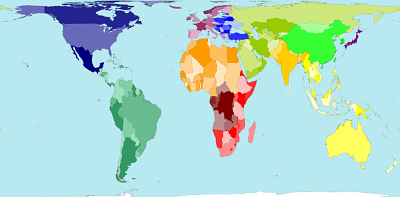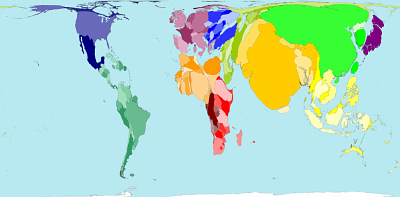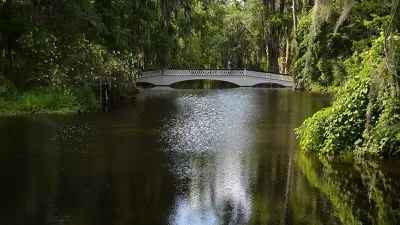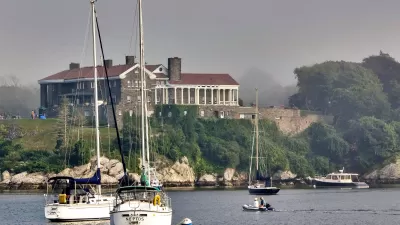What is wrong with this map?
What is wrong with this map?
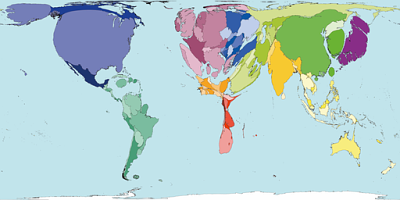
The map shown above is from a series created by the Worldmapper project and shows greenhouse gas emissions. It is an equal area cartogram in which each territory is "resized according to the variable being mapped". These maps are useful for making visual comparisons:
Greenhouse Gas Emissions
Source: Worldmapper
(Some other maps of interest to Planetizen readers: commuting time, public transport, passenger cars and a dramatic map on forest depletion.)
The World Wildlife Fund uses a more familiar thematic map to illustrate the concept of "eco-debtors" and "eco-creditors". WWF defines countries that consume more resources than they can recover or release more CO2 than they can can absorb themselves are "eco-debtors".
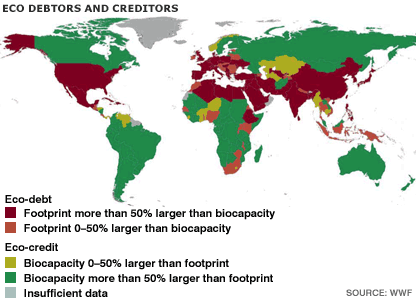
Source: WWF / BBC
An interesting new web-based tool for exploring data is Gapminder's Trendanalyzer which aims to reveal "the beauty of statistics by converting boring numbers into enjoyable interactive animations." You can try it out at "Gapfinder World 2006". Trendanalyzer was recently acquired by Google. Here is a screenshot of CO2 emissions (metric tons per capita).
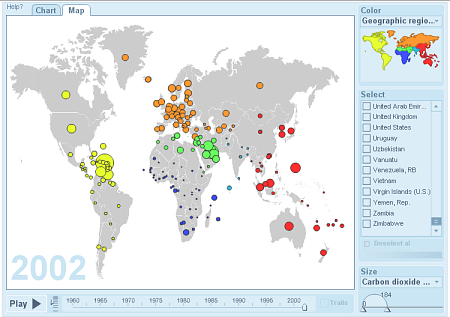
Source: Google / Gapminder
All of the above provide a global view of climate change. But what does it mean to me personally? Visit Alex Tingle's Flood Maps website which shows the areas that might flood as a result of global warming. Flood Maps has its limitations of course, but there is no denying the impact of seeing streets and neighborhoods you recognize under a blue pattern indicating possible flooding.

Source: Flood Maps by Alex Tingle
That's a map for the Southern California area. Are you in New York? Or Sacramento, CA?

Study: Maui’s Plan to Convert Vacation Rentals to Long-Term Housing Could Cause Nearly $1 Billion Economic Loss
The plan would reduce visitor accommodation by 25,% resulting in 1,900 jobs lost.

North Texas Transit Leaders Tout Benefits of TOD for Growing Region
At a summit focused on transit-oriented development, policymakers discussed how North Texas’ expanded light rail system can serve as a tool for economic growth.

Why Should We Subsidize Public Transportation?
Many public transit agencies face financial stress due to rising costs, declining fare revenue, and declining subsidies. Transit advocates must provide a strong business case for increasing public transit funding.

How to Make US Trains Faster
Changes to boarding platforms and a switch to electric trains could improve U.S. passenger rail service without the added cost of high-speed rail.

Columbia’s Revitalized ‘Loop’ Is a Hub for Local Entrepreneurs
A focus on small businesses is helping a commercial corridor in Columbia, Missouri thrive.

Invasive Insect Threatens Minnesota’s Ash Forests
The Emerald Ash Borer is a rapidly spreading invasive pest threatening Minnesota’s ash trees, and homeowners are encouraged to plant diverse replacement species, avoid moving ash firewood, and monitor for signs of infestation.
Urban Design for Planners 1: Software Tools
This six-course series explores essential urban design concepts using open source software and equips planners with the tools they need to participate fully in the urban design process.
Planning for Universal Design
Learn the tools for implementing Universal Design in planning regulations.
City of Santa Clarita
Ascent Environmental
Institute for Housing and Urban Development Studies (IHS)
City of Grandview
Harvard GSD Executive Education
Toledo-Lucas County Plan Commissions
Salt Lake City
NYU Wagner Graduate School of Public Service


























